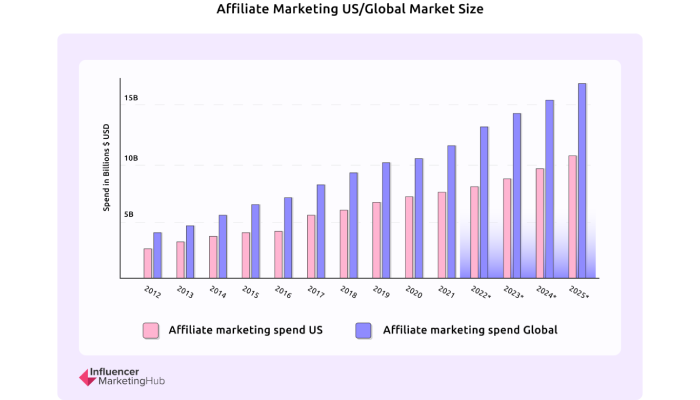Affiliate marketing is a digital partnership between businesses and content creators or influencers to drive sales through referrals. It’s a win-win: brands expand their reach, and affiliates earn a slice of the pie for each sale they generate.
What started as a niche tactic has now exploded into a key pillar of e-commerce, transforming how brands connect with audiences and boost revenue. Affiliate marketing is now a driving force behind the success of businesses, large and small.
As companies strive to stay competitive, they’re increasingly turning to this model to broaden their reach without blowing their budget on traditional advertising. The numbers behind this growth are nothing short of impressive.
In this article, we’ll break down the affiliate marketing statistics that tell the story of this booming industry and highlight the trends shaping its future.
General affiliate marketing stats
1. Affiliate marketing is experiencing explosive growth
Affiliate marketing’s explosive growth of 83% since 2017 shows its rising dominance in digital commerce. With global affiliate marketing spending expected to hit $15.7 billion by the end of 2024, businesses and marketers are clearly seeing the value. This surge in investment reflects a growing recognition that affiliate marketing is not only cost-effective but also scalable. As more brands tap into this channel, those who stay ahead of trends stand to gain the most.
2. Affiliate marketing’s service ecosystem is expanding
According to Influencer Marketing Hub, there are 9,600 affiliate-related services and companies worldwide. The affiliate marketing ecosystem is now more robust than ever. This includes agencies, platforms, and apps that help businesses manage, optimize, and expand their affiliate programs.
3. North America dominates affiliate marketing
Nearly half of the 9,600 affiliate services and companies are headquartered in North America. Regions like APAC, Europe, and Africa, while having fewer affiliate services, are catching up fast. With 2,300 in APAC, 1,900 in Europe, and 900 in Africa, these markets are steadily expanding their affiliate networks.
4. Retail leads as the top industry for affiliate marketing
In a 2023 survey, 39% of affiliate marketers and publishers operate within the retail industry, making it the dominant sector for advertisers and agencies. The retail space offers vast opportunities for affiliates to promote a wide array of products, from fashion to electronics.
5. Amazon Associates is still the top affiliate network
Amazon Associates continues to be the top choice for affiliate marketers, with 58.5% of them using the platform. Its vast product selection and trusted brand make it an attractive option for affiliates looking to monetize their content easily.
Affiliate marketing challenges statistics
6. Traffic generation remains a major obstacle for affiliates
45.3% of affiliate marketers identify generating traffic as their biggest challenge. While traffic is crucial, converting that traffic into sales is also a significant hurdle, as 19.5% of respondents noted. For marketers, mastering both aspects is key to driving sustainable success in affiliate marketing.
7. Managing affiliate relationships
68% of organizations find maintaining strong partnerships with affiliates challenging. Building and sustaining these relationships demands significant effort. For businesses, this requires dedicated resources to ensure collaboration.
8. Brand consistency and fraud concerns
66% struggle with maintaining brand consistency across affiliate channels, while the same percentage deal with fraudulent activities like fake leads. Both issues pose a threat to brand reputation and performance.
9. Commission structuring and tracking issues
46% of organizations face challenges in creating fair commission structures and accurately tracking sales or leads. These are key to motivating affiliates and assessing campaign success.
10. Affiliate content visibility among younger generations
Less than half of millennials (45.3%) and Gen Zers (46.6%) reported encountering affiliate content on websites. This suggests that while affiliate marketing is effective, it may not always be visible or recognizable to younger audiences.
Affiliate marketing benefits statistics
11. High ROI drives affiliate marketing’s appeal
In Forrester’s study, 24% of respondents point to the high return on investment (ROI) as a major strength of affiliate marketing. This channel allows businesses to achieve significant results with relatively low costs, making it a standout in terms of cost-effectiveness.
12. Constant influx of innovative partners
28% of respondents see the steady flow of new, creative marketing partners as the unique strength of affiliate marketing. This constant innovation helps businesses stay fresh and reach new audiences through diverse collaborations.
13. Clear incremental value
Another 28% highlight affiliate marketing’s ability to provide clear, measurable value beyond other channels. It’s easy to track how affiliate efforts contribute directly to business growth, making its impact transparent.
14. Ease of management and transparency
27% appreciate the simplicity of managing affiliate marketing compared to other channels. Additionally, 26% value its transparency, as it can be directly tied to sales and easily tracked for performance.
Affiliate marketing performance
15. Affiliate marketing enhances customer retention
Another 22% of marketers believe affiliate marketing plays a significant role in improving customer retention and loyalty rates. Affiliates can foster trust and personalize the customer experience, which drives repeat business.
16. Affiliate marketing delivers exceptional effectiveness
With a 92% effectiveness rate, affiliate or partner marketing has proven itself to be a powerhouse in the marketing world. This level of success rivals that of email marketing, long considered one of the most reliable channels for driving engagement.
17. Average website traffic levels for affiliate marketers
The average monthly website traffic for affiliate marketers stands at 56,673 visitors. For site owners, this level of traffic presents solid earning opportunities, and optimizing RPMs can significantly boost affiliate income even without major traffic spikes.
18. Consumers trust affiliate sites for purchasing decisions
According to Partnerize, 56% of online consumers have made purchases through affiliate sites. These websites review products and earn revenue from purchases made by readers. This demonstrates the power of trusted reviews and recommendations in driving consumer buying decisions.
Affiliate marketing revenue and earnings statistics
19. Affiliate marketing delivers high ROI for businesses
According to a report by IAB Marketing, businesses can earn an impressive $14 for every $1 spent on affiliate marketing, representing a 1400% ROI. This high return highlights the efficiency and profitability of affiliate marketing as a performance-based strategy.
20. Affiliate marketing earnings per 1,000 visitors
On average, affiliate websites earn $149.76 for every 1,000 visitors, highlighting the potential profitability of optimizing traffic. Even modest improvements in visitor numbers can lead to significant income boosts when paired with effective affiliate strategies.
21. Top-performing affiliate marketing niches
According to Authority Hacker, the top three affiliate marketing niches—education & e-learning, travel, and beauty & skincare—generate the highest average monthly incomes. Education & e-learning leads at $15,551, followed by travel at $13,847, and beauty & skincare at $12,476. These niches showcase the lucrative potential for affiliate marketers, driven by growing demand in online learning, renewed travel interest, and the booming beauty industry.
22. High commission opportunities with SaaS products
SaaS-based products offer generous commission rates, ranging from 20% to 70%, making them highly attractive for affiliate marketers. These high commissions reflect the value of subscription-based services, which often provide recurring revenue for affiliates.
23. Strong earning potential for affiliate marketers
The average affiliate marketer earns $8,038 per month, showcasing the substantial earning potential of this marketing channel. This income reflects the success many marketers achieve through effective partnerships and optimized strategies. For businesses and affiliates alike, it highlights the financial rewards possible with consistent effort and smart affiliate management.
Affiliate marketing strategies statistics
24. Senior marketers prioritize affiliate marketing expansion
78% of senior marketers are planning to expand their affiliate marketing efforts. This strategy is becoming a priority for growth. Marketers recognize the value of integrating new technologies, such as AI and automation, to streamline campaigns and boost performance.
25. Companies are investing in emerging technologies with affiliate marketing
22% of marketers view affiliate marketing as a key tool to invest in emerging technologies. This shows the channel’s potential to evolve alongside new tech trends like AI and automation.
26. The impact of market research on affiliate earnings
Marketers who base their product choices on thorough market research earn 47.16% more compared to those who rely solely on commissions or personal experience. This approach ensures that affiliates promote products with proven demand, aligning with audience needs and boosting conversion rates.
27. Affiliate marketers turn to AI for content creation
A significant 79.3% of affiliate marketers are adopting AI-driven content creation to enhance their efforts. This shift allows them to produce content more efficiently and tailor it to audience preferences, ultimately improving engagement and conversions.
28. SEO remains the top traffic driver for affiliate marketers
A significant 78.3% of affiliate marketers rely on SEO as their primary traffic source, emphasizing the importance of organic search in driving affiliate success. Additionally, 35.5% use organic social media to boost traffic. These strategies offer cost-effective ways to attract relevant audiences, making them key to long-term affiliate growth.
29. Affiliate marketing for awareness and consideration
In the U.S., 56% of marketers use affiliate marketing to build brand awareness, while 58% utilize it to drive consumer consideration. This highlights the dual role affiliate marketing plays in guiding potential customers through the sales funnel.
30. Affiliate marketing’s budget disparity despite its performance
According to Forrester’s study, only 7% of respondents consider affiliate marketing a top priority for budget allocation despite its effectiveness. This shows a disconnect between its value and how much businesses are willing to invest. Companies may be overlooking its potential impact.
Interestingly, a lot of investment in influencers, especially nano influencers, is tied to affiliate marketing partnerships. This suggests the channel has a bigger budget impact than direct allocations show.
Wrapping up
These numbers speak volumes about the power and potential of affiliate marketing. From the high ROI to the growing adoption of AI-driven content creation, the data shows that smart strategies can lead to significant gains. Whether you’re looking to boost traffic, refine your partnerships, or tap into new tools, affiliate marketing is an adaptable and profitable channel.
Now’s the time to let these insights guide your approach, maximizing both your earnings and reach. Let the stats fuel your strategy—and watch your results soar.









More Stories
Best Halloween Amazon deals on costumes, candy and more
20 Hobbies That You Can Turn into Hustles to Earn $40 An Hour – The Aesthetic Abode
Affiliate marketing spend will pass $10 billion this year in the US. Here’s what’s driving it